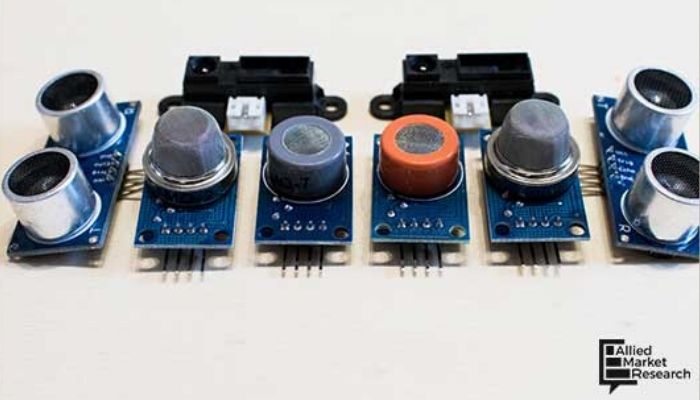Gas Sensors Are Now To Be Equipped With Ionic, Wireless and Nanowire Technology

24 Jun
2020
A gas sensor is a tool that detects the presence or concentration of gases in the atmosphere. Gas sensors can detect the gases depending on the current flow conducted in the chemiresister. A chemiresistor is a material that changes its electrical resistance in response to variations in the proximate chemical environment. The commonly used chemiresistor is Tin Dioxide (SnO2) which is an n-type semiconductor that has free electrons. Electrochemical gas Sensor, Calorimetric gas Sensor, Acoustic based gas Sensor, Metal Oxide-based gas Sensor, Optical gas Sensor, etc. are the common types of the device.
Benefits of Gas Sensors-
- Gas leakages can create oxygen deficiencies and can result in explosions in the environment. Cosmos gas detectors tend to sense gases that humans cannot smell or see, thereby safeguarding individual lives and business.
- National and international organizations have already made guidelines regarding workplace safety and enforced the safety regulations. So, having a gas detector on board, a business venture can ensure the required safety measures in the workplace.
- Local authorities in the United States are required to install carbon monoxide detectors in the houses so that if there is any gas leakage, it can be detected immediately. In such cases, handheld flammable gas detectors are used to trace leaks from natural gas lines, propane tanks, butane tanks, or other hazardous gas to avoid the risks.
COSHH regulations mandate ammonia gas detection system for manufacturing units-
According to gasworld, the leading news portal for the global industrial gas sector, Ammonia gas is regarded as a toxic gas under COSHH regulations. So, there is a need to have an ammonia gas detection system in every manufacturing unit to comply with the COSHH dictums. But, one of the major disadvantages of the contemporary ammonia gas sensors is that they are quite inappropriate to use in certain cases, especially in refrigeration plants. Existing electrochemical sensors are generally specified to -20 degree centigrade and therefore, it is not suggested to use electrochemical sensors for a longer duration. The reason is, at -20 degrees centigrade there is little water vapour in the air and so the ammonia gas detector cannot work properly. Thus, by adopting advanced materials and through careful optimisation of the design, gasworld has successfully developed and released a series of long-life ammonia sensors based on Ionic technology. The new technology doesn’t use water in electrolyte so as to reduce the temperature upto -40 Degree Centigrade. This facilitates to monitor an accurate and reliable ammonia gas detection particularly for refrigeration purposes.
Traditional gas sensors to be replaced with advanced devices-
As per GE Research Webwire, a unique new gas sensor has been designed that will achieve a new level of performance which was previously considered infeasible with conventional gas sensors. The sensor design happens to share the mathematical principles of multiple outputs with traditional analytical instruments without using their large power, size, and cost limitations.
The launch of Bioelectronic Ammonia Gas Sensor to revolutionize many industries-
Recently, Azosensors has published a news regarding the launch of the most sensitive Bioelectronic Ammonia Gas Sensor. The University of Massachusetts Amherst has developed a new sensor that will use the electric-charge-conducting protein “nanowires” obtained from Geobacter bacteria to supply biomaterials for electrical devices. The microorganisms tend to develop hair-like protein filaments that function as nanoscale “wires”. The wires are then combined with other pathogens, connected to the electric-charges, and left for the nourishment purpose.
According to Allied Market Research, the global gas sensors market is expected to grow at a CAGR of 6.4% from 2020 to 2027. The requirement to constantly monitor and control gas emissions by various industrial processes creates high demand for gas sensors. Uses of gas sensors happen to vary from industrial to domestic purposes such as monitoring air pollution, chemical processes, and exhaustion from combustion engines, etc.
In the last few years, immense efforts have been laid to discover new sensing materials, new ways of materials processing, new types of devices, and so on, improving gas sensing performances to a significant extent.

Koyel Ghosh
Author’s Bio- Koyel Ghosh is a blogger with a strong passion and enjoys writing in miscellaneous domains, as she believes it lets her explore a wide variety of niches. She has an innate interest in creativity and enjoys experimenting with different writing styles. A writer who never stops imagining, she has been serving the corporate industry for the last five years.
Avenue: Entire Library membership of Allied Market Research Reports at your disposal
- Avenue is an innovative subscription-based online report database.
- Avail an online access to the entire library of syndicated reports on more than 2,000 niche industries and company profiles on more than 12,000 firms across 11 domains.
- A cost-effective model tailored for entrepreneurs, investors, and students & researchers at universities.
- Request customizations, suggest new reports, and avail analyst support as per your requirements.
- Get an access to the library of reports at any time from any device and anywhere.
Related Post
-
How are Submarine Cables Transforming Global Connectivity with Enhanced User Experience?
-
Endoscopy Procedures: Transformations in Techniques and Applications
-
AI-Powered Video Analytics: How the Product Actually Works for enterprises
-
Painting Robots: Transforming Precision Coating and Creative Applications
-
Innovations in Pharmacovigilance Systems Advancing Patient Safety
-
Understanding Edge Security: Keeping Data Safe Near the Source
-
Exploring the Use and Advancements of 3D Laser Scanners in Professional Applications
-
Reinforcing Industrial Controls with Smarter Tools and Training








